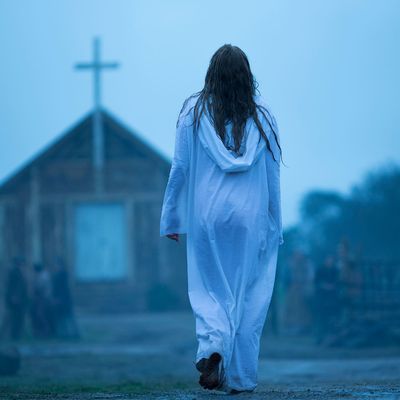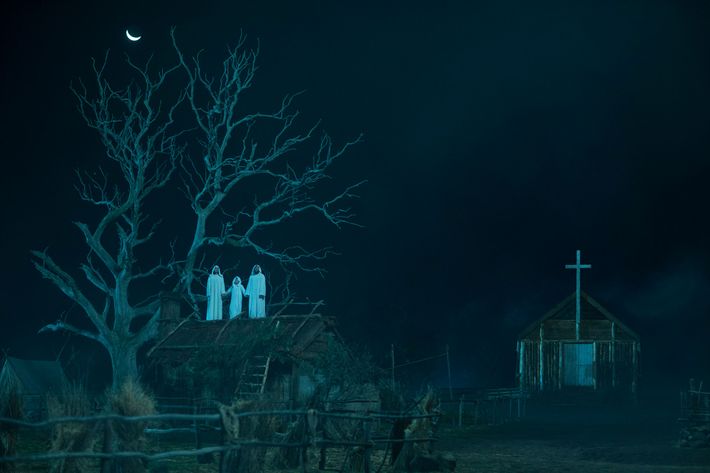
Spoilers ahead for The Leftovers season-three premiere.
The LeftoversÔÇÖs third and final season begins, like the second, with a mysterious dialogue-free sequence in another place and time. In season two, it was a prehistoric vignette involving a pregnant cavewoman, a venomous snake, and a possibly inter-dimensional earthquake. Season threeÔÇÖs opener is a little less elliptical: The congregation of a 19th century Christian sect called the Millerites begins to dwindle after a preacher sets several successive (incorrect) dates for the Rapture. Millerism was a worldwide movement built on William MillerÔÇÖs prediction that Judgment Day would come on October 22, 1844 ÔÇö a date known ever after as the Great Disappointment. Those failed ascensions echo the episodeÔÇÖs present-day action, wherein Kevin Garvey is back in police uniform, trying to keep the Texas town known as Miracle from blowing up again as the seventh anniversary of the Departure approaches, sparking predictions of apocalypse.
Showrunner Damon Lindelof says the idea took off in the earliest days of the season-three writerÔÇÖs room. First, he made everyone read and discuss Leon FestingerÔÇÖs When Prophecy Fails: A Social and Psychological Study of a Modern Group That Predicted the Destruction of the World. ÔÇ£We were talking about the book obsessively over the course of the first month of breaking the story,ÔÇØ says Lindelof. ÔÇ£Festinger and his team of well-educated sociologists and psychologists were able to embed with this woman in Chicago who claimed to be communicating with extraterrestrials, who told her the world is going to end, and she has a very specific date for it. She published a story in the local newspaper and they found her and said, ÔÇÿCan we be there with you for the month leading up to the end of the world?ÔÇÖ And so they were there at Ground Zero when the world didnÔÇÖt end. When the world doesnÔÇÖt end the first time, the woman is like, ÔÇÿOh I got the date wrong.ÔÇÖ She does it three times before people say it isnÔÇÖt working. ThatÔÇÖs cognitive dissonance, and that became an interesting idea.ÔÇØ
The novelist Tom Perrotta, author of The Leftovers ÔÇö the novel ÔÇö and LindelofÔÇÖs partner in the writing room, had first brought up the Great Disappointment during season two after reading about the Millerites in another semi-scholarly book, Whitney CrossÔÇÖs The Burned-Over District, a study of religious movements in Western New York. Reza Aslan, the showÔÇÖs religion expert, chimed in that they were one of his favorite ÔÇ£end-time groups.ÔÇØ ÔÇ£Like a lot of ideas we explore in the writers room, it took a while to percolate and find its place in the show,ÔÇØ said Perrotta. That time came when Lindelof discovered that the Millerites had a large branch in Australia ÔÇö the ultimate destination for the show. He brought in some printouts one day and told his writers, ÔÇ£WeÔÇÖre doing this. WeÔÇÖre going to show it.ÔÇØ

ÔÇ£I loved this idea of dressing up in white, getting up on your roof and waiting, and nothing happening,ÔÇØ Lindelof says. ÔÇ£And so when in the episode we literally pivot off of that woman after the third time and sheÔÇÖs been shunned by her family, and you pan across their white bodies, then youÔÇÖre suddenly on the Guilty Remnant ÔÇö the parable is perhaps a little too on the nose. But at the end of the day itÔÇÖs called The Leftovers! The characters are dealing with apocalypse fever. Do they feel the worldÔÇÖs going to end on the seventh anniversary? Do they feel thereÔÇÖs going to be another departure?ÔÇØ ItÔÇÖs exactly the imminence of that supposed Second Coming that prods KevinÔÇÖs brother-in-law, the Reverend Matt Jamison, to start compiling the Book of Kevin, a handwritten new testament and the title of the episode: ÔÇ£MattÔÇÖs attitude is, ÔÇÿI donÔÇÖt know whatÔÇÖs going to happen but Kevin will be a part of it.ÔÇÖÔÇØ

